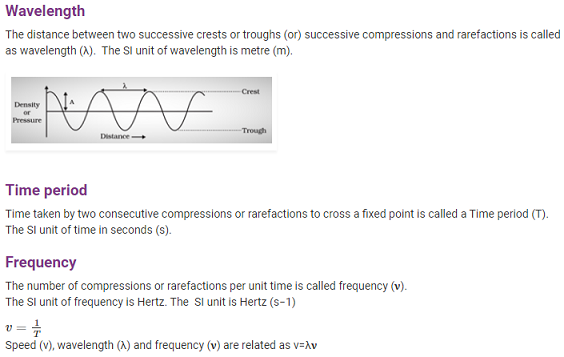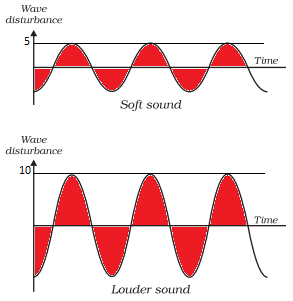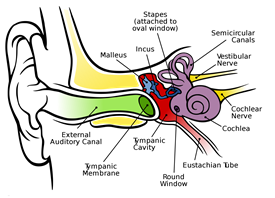Introduction to waves
A wave is a disturbance in a medium which moves from one point to another and carries energy without a net movement of particles. It may take the form of elastic deformation or a variation of pressure.
E.g: Rubber cork on the water that goes up and down when a rock falls in the water creates a ripple.
Particle motion of mechanical waves
(i) Transverse Waves
Particle motion is perpendicular to the direction of wave motion. This type of wave is a mechanical wave.
E.g: Light and Mexican wave in a stadium.
(ii) Longitudinal waves
Particles travel parallel to the direction of wave motion, by means of successive compressions or elongations. This is also a mechanical wave.
E.g: Sound waves in air.
Introduction to sound waves
Sound needs a medium to propagate. The matter or material through which sound propagates is called a medium. When particles vibrate about their mean positions, it pushes a region of compressed air, creating a region of high pressure, followed by a region of low pressure as the particle retreats to its mean position. The sound wave propagates by compressions and rarefactions of particles in a medium. Sound propagation can be visualised as the propagation of pressure variations in the medium.

Amplitude
The magnitude of disturbance in a medium on either side of the mean value is called an amplitude (A).
As shown in the figure below, the unit of amplitude will be the density or pressure. Distance between mean position and crest (maximum displacement).

Volume
Volume or loudness of a sound depends on the amplitude. The force with which an object is made to vibrate gives the loudness.
Higher force → higher amplitude → louder sound
The amount of sound energy flowing per unit time through a unit area is called the intensity of sound.

Note and Tone
A sound of a single frequency is called a tone. A sound produced with a mixture of several frequencies is called a note.
Quality of sound
The richness or timber of sound is called the quality. Sound with the same pitch and loudness can be distinguished based on the quality. Music is pleasant to the ears while noise is not. But they both can have the same loudness and pitch.
Speed of sound
Sound travels through different media with different speeds. Speed of sound depends on the properties of the medium: pressure, density and temperature
Speed of sound: Solids > Liquids > Gases
Speed of sound in air = 331 m/s at 00C and 344 m/s at 22∘ C
When a source emits sound with a speed greater than the speed of sound in air, it creates a sonic boom which produces shockwaves with lots of energy. They produce a very loud noise which is enough to shatter glass and damage buildings.
Reflection of Sound Waves
Like light, sound also follows laws of reflection, it bounces off the surface of solid and liquid.
Echo
The phenomenon where a sound produced is heard again due to reflection is called an echo.
E.g: Clapping or shouting near a tall building or a mountain.
To hear distinct echo sound, the time interval between original and reflected sound must be at least 0.1s. As sound persists in our brain for about 0.1s. Minimum distance for obstruction or reflective surface to hear an echo should be 17.2 m. Multiple echoes can be heard due to multiple reflections.
Sonar and Radar
SONAR – Sound Navigation And Ranging.
It is a technique that uses sound or ultrasonic waves to measure distance. The human range of hearing is 20Hz- 20kHz.
What are Ultrasonic sounds?
Ultrasonic sounds are high-frequency sound having a frequency greater than 20kHz (inaudible range).
Applications of Ultrasound
(i) Scanning images of human organs
(ii) Detecting cracks in metal blocks
(iii) Cleaning parts that are hard to reach
(iv) Navigating, communicating or detecting objects on or under the surface of the water (SONAR).
Sonar consists of a transmitter and detector mounted on a boat or ship. The transmitter sends ultrasonic sound waves to the seabed which gets reflected back and picked up by the detector. Knowing the speed of sound in water, distance can be measured using: 2d=v×t. This method is called echo-location or echo ranging.
Reverberation
Persistence of sound because of multiple reflections is called reverberation. Examples: Auditorium and a big hall.
Excessive reverberation is undesirable and to reduce this, halls and auditoriums have sound-absorbing materials on the walls and roofs. E.g: Fibreboard and rough plaster.
Doppler’s effect
If either the source of sound or observer is moving, then there will be a change in frequency and wavelength for the observer. The frequency will be higher when the observer moves towards the source and it decreases when the observer moves away from the source.
Example: If one is standing on a street corner and an ambulance approaches with its siren blaring, the sound of the siren steadily gains in pitch as it comes closer and then, as it passes, the pitch suddenly lowers.
Human Ear
The ear is a sensitive organ of the human body. It is mainly involved with detecting, transmitting and transducing sound and maintaining a sense of balance is another important function of the human ear. Human ear includes:
- The outer ear or the visible part of the ear is called the pinna.
- Pinna collects sound from the surroundings.
- Sound passes through a tube called an auditory canal.
- Eardrum (tympanic membrane) vibrates in response to incident sound waves.
- Vibrations are amplified and transmitted further by three bones hammer, anvil and stirrup in the middle ear to the inner ear.
- In the inner ear, cochlea converts pressure signals into electrical signals.
- Electrical signals are transmitted by the auditory nerve to the brain for interpretation.
